Are you using the Art of Storytelling to build your story brand and dominate your competitors?
Storytelling: A Fundamental Guide to Becoming THE Storyteller by Learning How to Write a Story that Persuades...
There’s no better way to build relationships than with stories and becoming the storyteller.
If you have a blog, Facebook page or another publishing platform for communicating with your tribe, then, your job is to fill that platform with stories that persuade your prospects to take an action you want them to take.
So, you must learn how to write a story that sells, and the art of writing stories.
Stories aren’t just long tales. Good storytelling reveals evidence. Stories provide proof of your thesis.
People tell me all the time, “David, you're a born storyteller.”
And I do have a bit of a reputation for my storytelling ability in email and blog posts. Below, you’ll see one that came in from Felicia Slattery, one of the top speaking coaches in the US.
But the truth is, I've never met a born storyteller.
And I certainly am not one.
All the great persuasive storytellers that I know have learned that skill through practice and patience.
It IS a skill. And if you don't learn the skill, then chances are that you’ll fall flat.
Instead of informing and entertaining, you become self-indulgent and annoying.
Don’t do that.
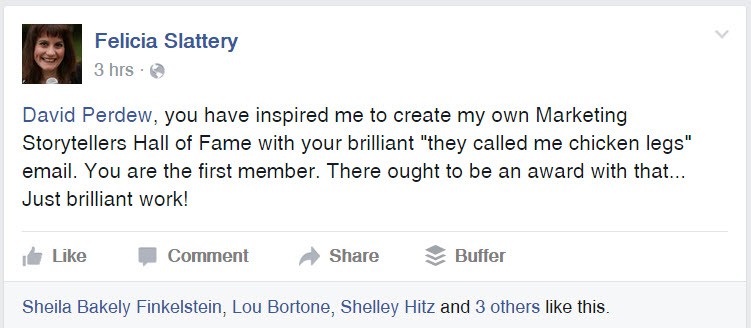
Learn the storytelling process
Why? Stories sell. If you're in business (and I assume that everyone reading this is in business), it's really important for you to focus on why you do what you do.
It’s the same with storytelling.
The London School of Business did a study on selling with stories and it confirmed what we all suspected.
People retain 65 to 70 percent of information shared through stories while only 5 to10 percent of information is retained through dry presentation of data and statistics.
Storytelling is the most effective way to persuade people to take an action because they are invested in the story AND they want to listen to your tale instead of being resistant to a sales message.
Great storytelling is the best way to build real relationships. And as The Storyteller, you have the power and authority of the microphone - or the computer keyboard, and can build a relationship with dozens or even thousands of people at a time.
One of my favorite sayings is that every action should have a marketing result. That means every activity becomes a profit center.
Every story, every communication, every persuasive email – all are little sales people running into the world to represent you and your brand. If you’re not building relationships with those tools, you’re driving folks away.
That is exactly why we focus on storytelling and how to get marketing results from stories.
Storytelling is even more important today because of the shifting communication platforms
There are two basic schools of marketing online. The first is old school. The second is new.
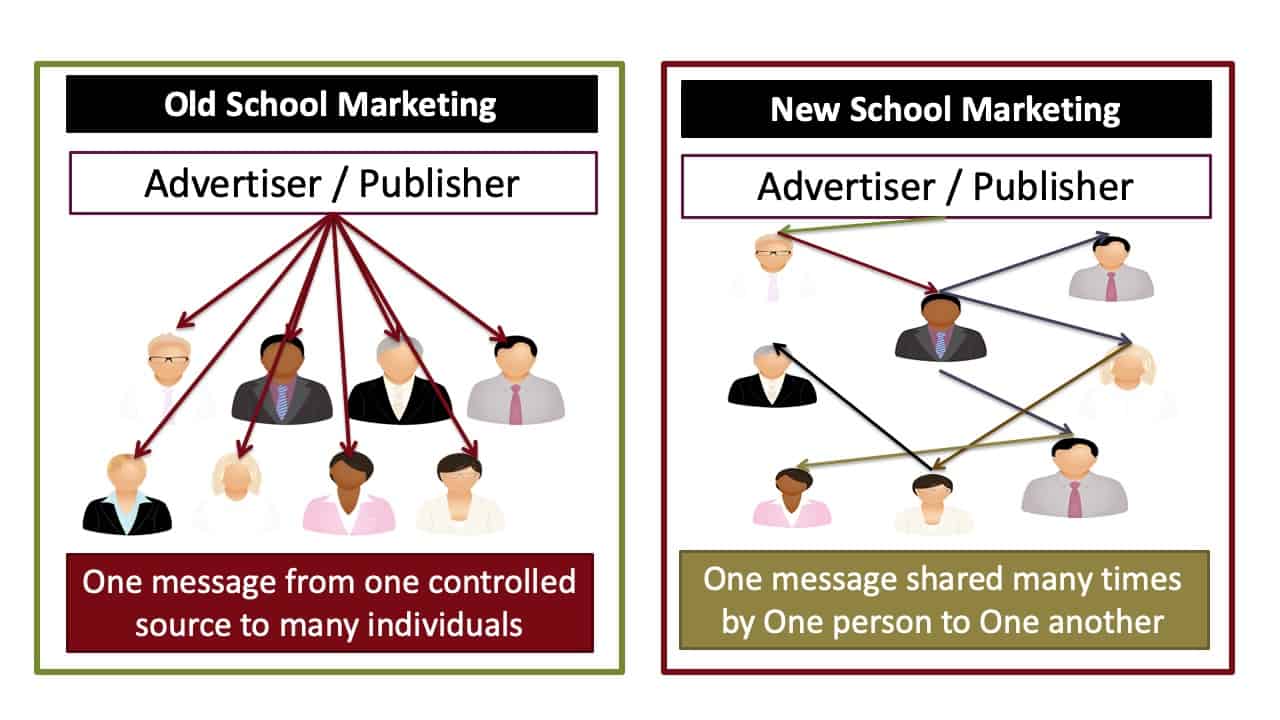
Old School Marketing
To understand Old School vs New School, you have to first understand Advertising and Publishing. They’ve been intertwined for centuries.
The publisher controlled the advertising because he had the press or broadcast spectrum.
In the old days, an advertiser or a publisher sent out a single message from a single source trying to reach as many people as possible and convert them by controlling who saw that single message. It was a numbers game, a shotgun blast.
The one-to-many broadcast method is still effective, but not as effective or FAST as more modern methods.
The Old School approach was called interruption marketing. And it is basically the province of commercial publications such as magazines and newspapers, television and all of that.
Here's a quick example of how interruption marketing is changing:
How do you watch TV today?
Do you sit down at the appointed time when your favorite program is broadcast?
That's the way it was when I was growing up. If you wanted to watch your favorite program, you sat down in front of the TV at the appointed time and watched - including the commercials or you might miss part of the program.
Today, according to a 2017 Accenture global study, only 23 percent of people around the world watch their favorite programs on a television set. (The rest are watching on mobile, computer or gaming devices.)
And of those 23 percent, many of them will watch recorded programs while fast-forwarding through the commercials.
Old School advertising has shifted. But to what…
New School Marketing…
Today, the audience is in control of the distribution of the content. And the better the story, the better the distribution because it’s all about sharing.
With the advent of social media, the number of shares and views is the key to everything. Unknown stars are born on Youtube and Instagram because people relate and it spreads like wildfire.
Relationships are built with the new “influencer”... which is kind of weird when you think about it, because the relationship only exists as long as they follow the influencer and check in regularly for new content.
Why?
Because they’ve created a story about themselves that their followers love and that they will distribute for them… They feel connected to a star...
Today, advertisers and publishers send out a message to the masses - hopefully through an influencer - and then rely on individuals to share that information.
If the story is not share worthy, it dies.
Creating viral content is all about sharing good stories.
Big brands have finally caught on and realized that using storytelling techniques is the future of advertising
When NBA All Star Dwayne Wade announced that the 2018-2019 season would be his last as an active pro basketball player, Budweiser (master storytellers for years) saw an opportunity to honor him.
Wade had been swapping jerseys with other NBA players after key games. Budweiser took that interesting fact about Wade and produced a poignant story about him.
In less than a month, the YouTube video had 5 million shares.
It’s impossible to watch the 4-minute video without being moved by his humanity.
And if you watch it closely and you’ll see the 7-step storytelling process… because all great stories follow that process.
The storytelling process is the reason Facebook and YouTube are so amazing - for good or bad.
We’re entertained by the stories and allow ourselves to get sucked in to Facebook and YouTube and Instagram because we love to share those stories with other people.
Click on the video to watch the story...
If storytelling is so effective, why isn’t everyone doing it?
There’s a serious problem with storytelling - and it’s mostly between your ears.
Right now, you're probably thinking…
- I don't have any stories!
- My stories aren't interesting…
- Nothing interesting ever happens to me…
Of course, that’s not true.
Once you learn how to tell stories from your everyday life that persuade people to take the action you want them to take, you’ll realize that EVERYTHING is fodder for a good story.
And they don’t even have to be your experience. You can tell a story about something that happened to someone else if you talk about how it relates to you.
But maybe you’re thinking …
“I’m afraid of revealing too much about myself. I’m a very private person.”
It’s true. You can tell too much.
But you have to try really, really hard to reveal too much.
Below are a few examples of different ways to expose your heart while telling stories that move people to action. And sometimes that action is simply to like, share or comment. But that small action is enough to help you build better relationships which will in turn help your business.
Good storytellers use tragedy recounting terrible episodes in their lives that reveal the lessons they’ve learned. And by doing that, they establish immediate rapport and empathy with the audience. It’s the beginning of a relationship.
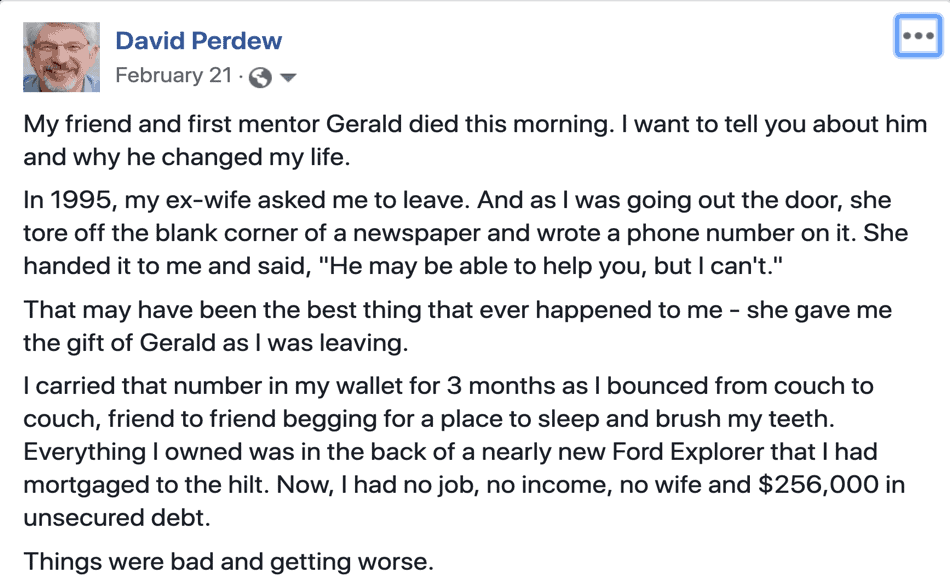

This was a long post. And while I wrote it as a tribute to my great friend and mentor Gerald, I also wanted people to understand the power of mentorship. To do that, I had to reveal the lowest point in my life and how Gerald helped me out of it.
My goal was not to sell anything. It would have been really crass to add at the bottom of the story, “And if you’d like to improve your life, hire me as a mentor too… and you’ll get what I got from Gerald.”
I would never do that.
But I definitely wanted to praise him and demonstrate how he helped me climb out of my hole. To do that, I had to expose my heart. People responded with likes, shares and comments. None were negative.
Is it manipulative? No, because I was writing from my heart and letting you into my world. If you never read another story I write, that’s okay too.
Risking ridicule or embarrassment, storytellers often reveal something really stupid, silly or emotional that’s happened in their lives. And of course, those episodes come with lessons that can be shared, or you can present a solution that helps your reader avoid that same mistake.
Below, is the first 100 words of a 900 word email. Now, you might be thinking, “900 Words! Who’s going to read a 900 word email?”
Many, many people did, and I got a ton of engagement. It was a story that led to an opportunity to meet personally and talk about a nutrition program.
“Subject: They called me chicken legs…
Hey there ~Contact.FirstName~
I’m really hesitant to tell you this because it’s a little embarrassing, but here goes...
When I was in junior high school in New Castle, Indiana, I got tagged with a nickname that haunted me for many years:
Chicken Legs!
Even now, when I look at my skinny legs, I think about those folks who called me chicken legs. In a minute, I’ll tell you how I got stuck with that name, but first let’s go back to a time long, long ago…
I was very skinny…”
I could talk about one of the most embarrassing and hurtful times of my youth, and what I learned from it, because I’m willing to be open and vulnerable with my community.
After years of reading these types of stories, the community expects it - no, demands it from me. I can’t get away with sending short, straight-to-the-point emails. My friend and mentor, Matt Bacak, makes millions with email. A 100-word email from Matt would be an epic post. His audience expects short and direct.
Mine does not respond to those.
If you're going to be successful online, especially if storytelling is going to be part of your portfolio, you become a bit more transparent.
To relate to people, you have to be relatable.
Be real.
So, I encourage you to let go of the facade that you try to hide behind. We all have that facade to protect us. But, in the end, it’s what holds us back.
Once you understand the process, learning the art of storytelling is simple.
Search your day with an open mind, and you’ll find story possibility after story possibility.
I guarantee you that interesting things are happening all around you.
You’re learning lessons every day and you can build stories from that experience. If not your story, you can tell stories about other people - living and dead - and relate to those to make them your own so they reveal the truth that you discovered in your daily living.
To get started telling stories from your life that persuade others, use our proven structure that works. That’s why I developed a 7-step storytelling template to tell persuasive stories with a point.
This 7-step process has worked since cavemen were telling stories around the campfire about the day’s events.
The 7-steps are:
- The Hook
- The Setup
- The Parachute
- The Theme
- The Transition
- The Sell
- The Tie Back - or Resolution
I describe each of those in the template itself, so be sure to grab it.
Wait, that’s not what I learned in high school English class…
Mr. Dicken was my English teacher. I loved him, and he taught me about great writing. We covered all four types of writing:
- Expository – Writing in which author’s purpose is to inform or explain the subject to the reader.
- Persuasive – Writing that states the opinion of the writer and attempts to influence the reader.
- Narrative – Writing in which the author tells a story. The story could be fact or fiction.
- Descriptive – A type of expository writing that uses the five senses to paint a picture for the reader. This writing incorporates imagery and specific details.
Persuasive Storytelling is not what you learned in college or in high school.
In journalism school, we’re taught to start with the LEDE - that’s always the most important information, not necessarily the most engaging.
And that’s important if you’re scanning the news site (or newspaper if you’re as old as me) because you can read the first couple of paragraphs of all the stories and get really well informed.
None of the four writing types really fit what we’re doing as storytellers… or do they?
Actually, ALL four types of writing are using in storytelling.
In a really good story, the teller is:
Shaping a situation (using descriptive writing) by telling a relevant story (using narrative writing) that helps the reader understand (using expository writing), the reader takes the action that you lay out (using persuasive writing).
Mr. Dicken would be proud of me.
I can’t really get into the entire 7-step process today in this blog post because it’s already gone on too long, but let’s look at the first step - The Hook...
The Hook is the KEY element in persuasive storytelling.
It has to be intriguing, shocking, surprising, astounding, paradoxical… You get the point. It’s a grabber.
Isn’t that usually the headline? Very often, it can be.
Let's look at a great hook.
One of our students, Tim Maudlin, came to us with a problem.
When I first met Tim, we had a short consultation call. He said, “You know, I don't think I actually have a business that can be converted to online.”
He did t-shirts for causes - charitable, personal or medical challenges, or church causes.
After talking a bit and taking our storytelling course, he produced a 66-second video. Remember, the hook is the first thing to grab your attention. Here’s the transcript of the video below:
“I thought I had just killed my boys.
Friday, March 2nd, 2012 is a day I'll never forget. That’s the day a tornado ripped apart my hometown. My boys didn't die that day. But five of our neighbors did.
The next day, March 3rd, 2012 is also a day I'll never forget because on that day I learned one very simple yet important lesson from one t-shirt that made a difference in my life and in my community.
It’s a lesson that I want to share with you and a story that will inspire you. T-shirts that inspire. The $89,000 tee shirt. How one tee shirt inspired and healed a broken community. Available at Amazon.com.”
Tim did a great job with is following our 7-step template and produced an intriguing story. There are some obvious places to improve that script and we go over it in the course, but his Hook was great!
Every parent wants to know what happened after he says...
“I thought I had just killed my boys.”
It’s real. It’s surprising. It’s gut-wrenching. And we want to close the loop it just opened. How. Why. What. Tell me more.
Related Posts
If you're ready to grow your business with content, our storytelling training course will help you become a master storyteller.
Trying to think of brand new content every time you have to write a blog post, an email or a sales page can be incredibly overwhelming.
When you start taking situations and events from your life and relating them to your business, it becomes easier to write. Plus your readers and prospects become more invested in your because of your openness and honesty.
Once you've mastered the strategy, you'll find yourself writing your next email or blog post while you're mowing the yard, taking a shower or washing the dishes because you've already mastered the structure and framework. Then when you sit down at the computer, the story and the content flows.
So if you're ready to master the skill of storytelling, you'll love this business storytelling training course. Click now and be sure to use the coupon on the bottom of the page

The Novice to Advanced Marketing System is a step-by-step system focusing on Team, Training and Tools to help novice to advanced business people build a Simple, Scalable and Sustainable business.
Founded by David Perdew over 15 years ago, he recently retired and his daughter, Jen Perdew, who has been working at NAMS since 2011 purchased the business.
Jen is now the President and CEO of NAMS and comes from a customer service, operations, and employee training background.
Jen has always loved digging in and getting her hands dirty with automation and coaching. Jen's an implementer and focuses on moving her clients as quickly as possible down the path to success. and has since taken over most of the technical training in the business. NAMS is one of the most successful online communities today, specializing in training and proprietary productivity software tools.
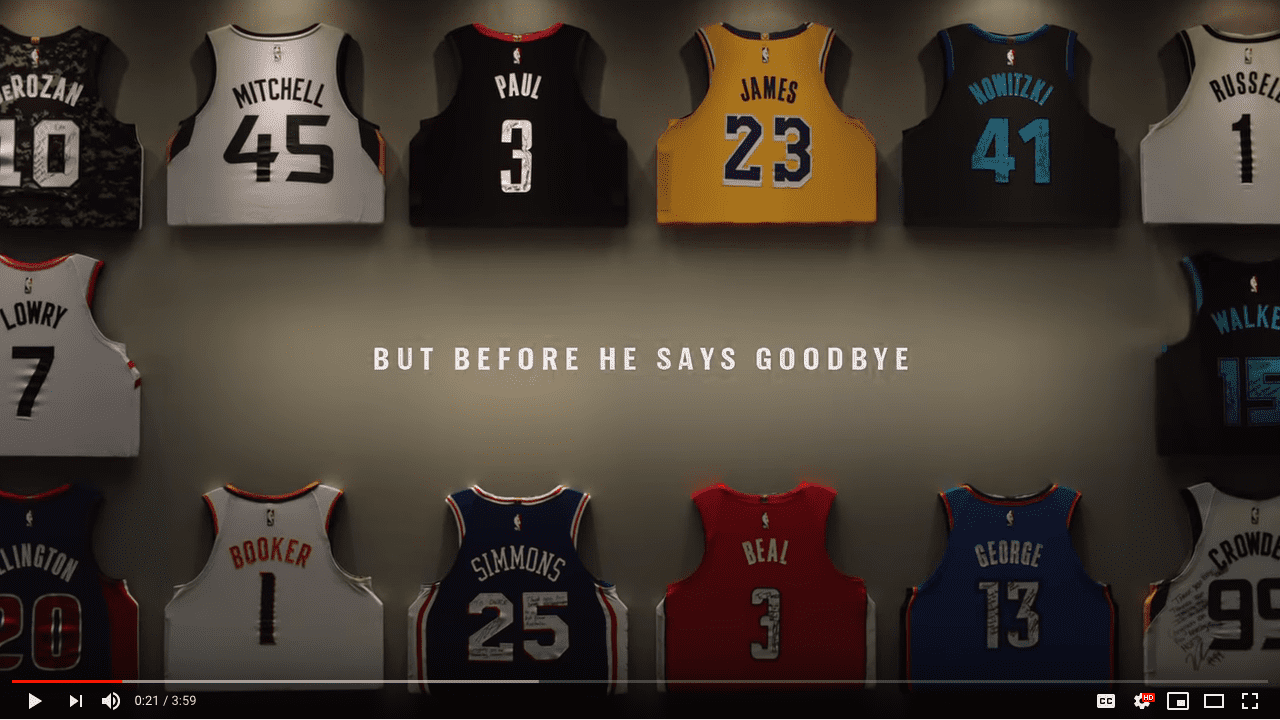

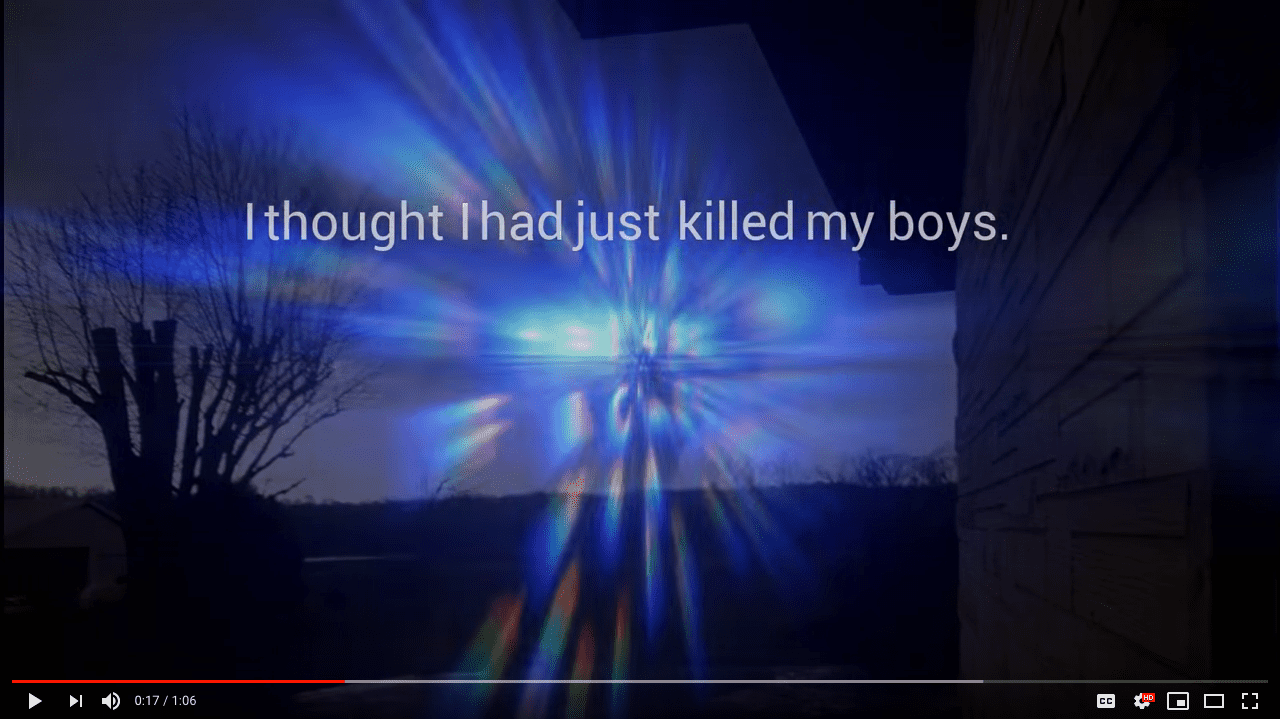

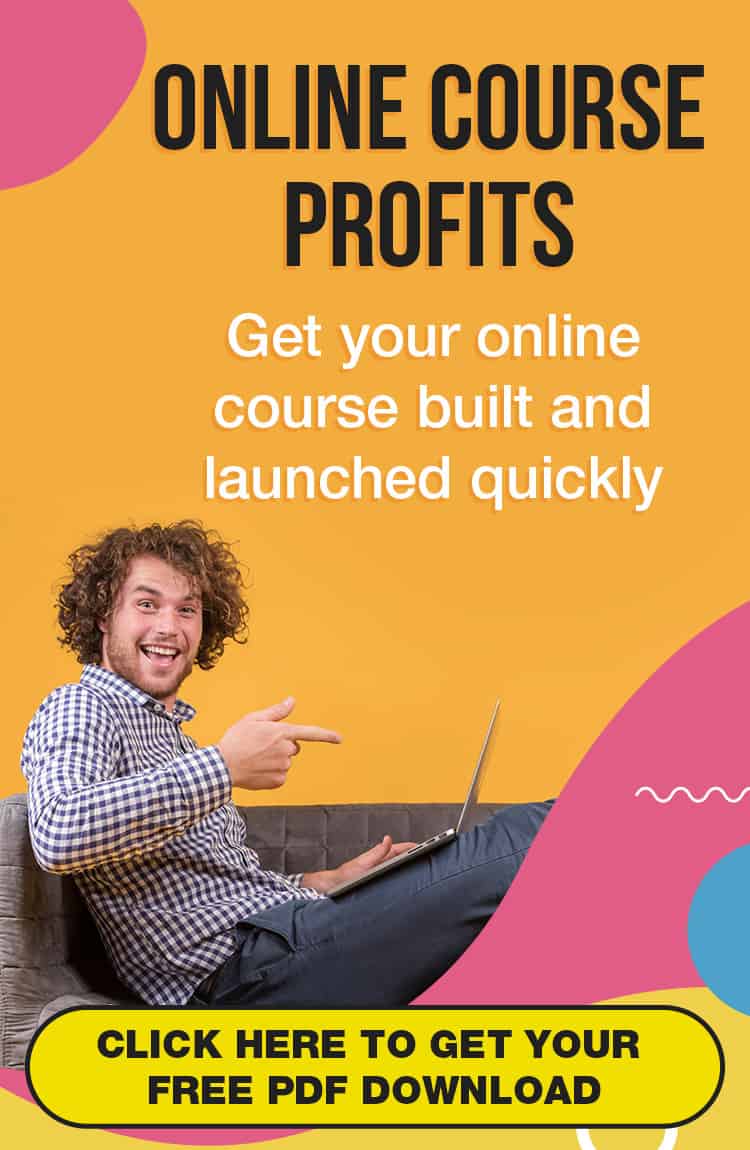

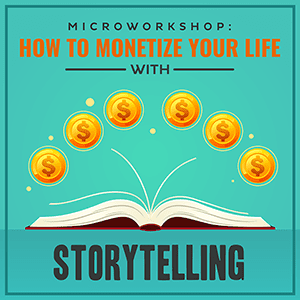






Story telling is key. Everybody says, “Content is king.” But they’re wrong. It’s a specific kind of content that tells a story your reader can insert him/herself in without any conscious effort on their part. They become a part of the story. Done right, they become the protagonist who overcomes whatever obstacle is in their way.
Awww shoot!
The example you wanted us to see about the Dwayne Wade story-telling in the video does not work.
The video keeps buffering with a large X inside the buffering circle.
Can this be fixed? Ive already shared this with someone who will likely have the same problem.
carolyna.forche7@gmail.com
Thanks.
Carolyn- They made this video private! But I’ve found a different version and added it to the page so you should have no problem watching now
Such a good read!!
I will definitely be taking these tips on board in my projects. Storytelling is such an important skill to build that relationship with your audience.
Thanks so much for the tips.